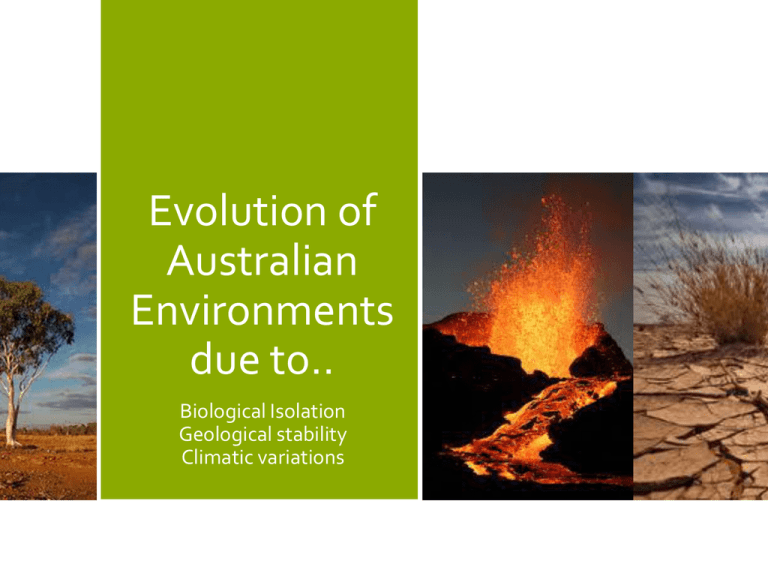Evolution of Australian Environments
advertisement

Evolution of Australian Environments due to.. Biological Isolation Geological stability Climatic variations Facts about Australia’s uniqueness • • • • • • • • • High fire rates Highly erratic climate Susceptible to extended periods of drought Highly isolated (We’re on an island!) Large amount of uniquely native species (compared to the rest of the world) Unique flora and fauna adapted to landscape Relatively flat continent Unique flora and fauna adapted to climatic conditions Low soil quality (low in phosphorus which allows for extensive plant growth) Why? Biological Isolation Geological stability Climatic variations Facts about Australia’s uniqueness • • • • • • • • • High fire rates Highly erratic climate Susceptible to extended periods of drought Highly isolated (We’re on an island!) Large amount of uniquely native species (compared to the rest of the world) Unique flora and fauna adapted to landscape Relatively flat continent Unique flora and fauna adapted to climatic conditions Low soil quality (low in phosphorus which allows for extensive plant growth) Why? Biological Isolation Geological stability Climatic variations Biological Isolation What is it?? Biological Isolation refers to when a collection of species do not have contact with another species that they are able to breed or mate with. This process can be man made or natural. Examples: Man made = scientist in a laboratory segregating species, Natural = natural disasters such as floods. Looking at the Natural History of Australia before humans, we will be focusing on the effects of Natural biological Isolation. Natural Isolation occurred when Australia split from Gondwanaland to form it own land form in isolation. Biological isolation This can occur when organisms travel to islands and then can no longer breed with organisms from the main land. Natural disasters such as earthquakes, volcano eruptions and mud slides can force populations into separate areas. This means that these organisms will either die out or evolve separately. (Wilderness bohanson, 2008). Natural Selection • Geographical Isolation contributed to Charles Darwin’s theory of evolution by natural selection. This theory evolved from the evidence and movement that scientists had found about how Australia formed before humans. • In short, Charles Darwin’s theory was that species change over time, or evolve in response to the environment. This is basically what biological isolation is; the change of species over time by being isolated from one another. Biologically isolated flora The flora in Australia has strong affinities with the flora of Gondwana, and below the family level has a highly endemic flora whose diversity was shaped by the effects of continental drift and climate change since the Cretaceous period. • Prominent features of the Australian flora are adaptations to aridity (low amounts of water) and fire which include scleromorphy and serenity. • Sclerophyll is a type of vegetation that has hard leaves and short internodes (the distance between leaves along the stem). The word comes from the Greek sclero (hard) and phyllon (leaf). • These adaptations are common in species from the large and well-known families Proteaceae (Banksia), Myrtaceae (Eucalyptus - gum trees), and Fabaceae (Acacia - wattle). Animals and plants evolve to life without specific predators or threats and ecosystems evolve to find an equilibrium where no one predator wipes out everything. In Australia this has lead to the evolution of flora and fauna that can survive in the harsh conditions they live in • This unfortunately increases the impact of introduced fauna species such as the rabbit, cane toad and even flora such as Patterson’s curse. Animal example An example of Biological Isolation and the evolution can specifically be seen when looking at the platypus. Large water rats were around in the Gondwana period. When Australia split from the larger sections of Gondwana, water rats in Australia where left without diversity in their breeding partners. As suggested by Charles Darwin, biological isolation resulted in the water rats in Australia forming into their own species, as we know as the platypus. Geological Stability What is it? Australia has been without volcanic activity or movement for many years due to being located relatively in the center of a tectonic plate (Australasian). The last volcanoes on the continent of Australia were active many years ago compared with other continents. This, combined with very little geological activity, has led to Australia having soil poor in nutrients. The state of the soils has had an influence on the Australian flora and fauna as those who were unable to adapt were also unable to survive. Geological stability Australia has low tectonic, volcanic and glacial activity. There are few mountain ranges and the landscape is generally flat, making it prone to floods and erosion, and therefore affecting the survival of flora and fauna. • What animal has adapted to Australia’s flat landscape? • What adaptions would plants need to make to deal with poor soil quality? Climatic Variations What is it? Australia experiences a relatively erratic climate in comparison to other continents of the world. There seems to be two main extremes, long, lean droughts in El Niño years and flooding rains in La Nina years (See wiki for further information). These periods can last anywhere from 1 – 10 years, this low level of predictability has had an impact on the adaptability and diversity of flora and fauna. The Australian climate varies on longer timescales, over decades and centuries. These variations are more subtle than yearly changes but can still have significant impacts on human life. Australians are well accustomed to short-term variations in climate, such as a particularly hot summer or low annual rainfall. However, it is important to recognise that the climate also varies over longer time-scales. For example, farming in some parts of Australia expanded into marginal agricultural areas during decades of good rainfall. However, many of these areas turned to dust bowls during the poor growing seasons associated with a downturn in the long-term rainfall cycle. Climate patterns Climate patterns on time-scales longer than decades also influence life in Australia. Short term climate variations are superimposed on long-term trends. It is these extremes in climate that have the greatest impacts on human activities. The landmass of Australia has been exposed to many extreme climate changes all of which have had an effect on the current landscape, flora and fauna. Some plants have developed deep root systems to access water in times of drought and some animals such as the Koala, has evolved with a relatively small brain to conserve energy. Adaptions to Australia’s erratic climate Plants Hard, glossy leaves resist water loss through transpiration Evergreens reduce energy usage Long, narrow leaves that hang vertically presenting small surface area to sun Small leaves, or none Dormancy Animals Water storage Metabolic adaptations to minimise water loss Energy efficient movement – eg. hopping Energy saving adaptations – eg. Koala’s brain Serotiny Serotiny is an ecological adaptation exhibited by some seed plants, in which seed release occurs in response to an environmental trigger, rather than spontaneously at seed maturation. The most common and best studied trigger is fire, and the term serotiny is often used to refer to this specific case. Possible triggers include: • Death of the parent plant or branch (this form of serotiny has been technically termed necriscence) • Wetting (hygriscence) • Warming by the sun (soliscence) • Drying atmospheric conditions (xeriscence) • Fire (pyriscence) • Fire followed by wetting (pyrohydriscence) Some plants may respond to more than one of these triggers. For example Pinus halepensis exhibits primarily fire-mediated serotiny, but responds weakly to drying atmospheric conditions. Similarly, some Banksia species are strongly serotinous with respect to fire, but also release some seed in response to plant or branch death. Flora releasing seeds after a fire Banksia (pictured) is a common species to have developed this trait along with the Australian Mountain Ash These have evolved uniquely due to poor Australian soils. Fire indicates the release of nutrients from burnt materials which is ideal conditions for the growth of new seedlings. Basically reducing wasted seeds due to being released onto soils with minimal nutrients.








